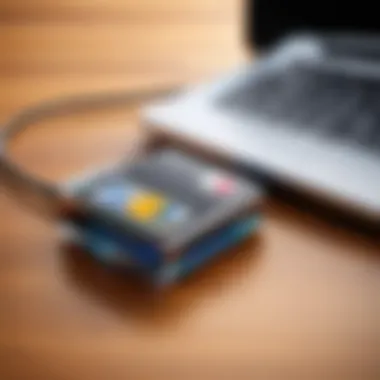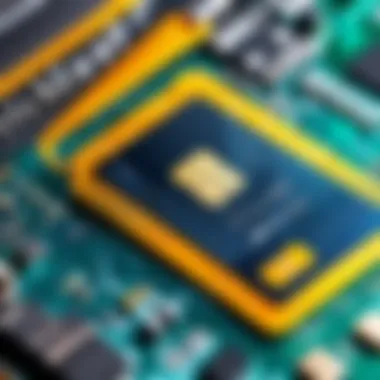In-Depth Review of Chip Technology USB Credit Card Readers


Intro
In the rapidly advancing realm of digital payments, USB credit card readers equipped with chip technology play a pivotal role. These devices offer enhanced security and functionality, setting a new standard for transaction methods. This analysis aims to shed light on the multifaceted aspects of these readers, providing IT professionals and tech enthusiasts with valuable insights.
Every detail, from hardware specifications to software functionalities, is crucial for a comprehensive understanding of how these devices operate. Not only do they facilitate secure transactions, but they also represent a shift in consumer expectations and merchant responsibilities regarding payment solutions. As we delve deeper into this analysis, we will explore the intricate relationship between hardware and software, the implications of chip technology, and considerations for effective implementation in various environments.
Prolusion to USB Credit Card Readers with Chip
The emergence of USB credit card readers with chip technology marks a significant advancement in the way we process transactions. As commerce shifts more towards digital platforms, the need for secure and efficient transaction methods becomes increasingly vital. USB credit card readers equipped with chip technology are designed to offer enhanced security, making them indispensable tools in today’s marketplace.
In this section, we will explore the defining characteristics of USB credit card readers and the underlying chip technology that enables their functionality. This analysis will provide IT professionals and tech enthusiasts with a clear understanding of the benefits and considerations associated with these devices, paving the way to assess their importance in modern financial transactions.
Defining USB Credit Card Readers
USB credit card readers are peripheral devices used for reading credit card information. They connect directly to computers or mobile devices via USB ports. This type of reader is primarily employed in point-of-sale (POS) systems, mobile payment solutions, and e-commerce applications. The versatility of USB connectivity allows for easy integration into various platforms.
The fundamental role of a USB credit card reader is to facilitate the transfer of data from the credit card to a processing system, usually involving payment gateways. These readers can operate in two primary modes: swiping for magnetic stripe cards and insertion for chip-enabled cards. The increasing prevalence of chip technology reflects a shift towards more secure processing methods.
Understanding Chip Technology
Chip technology, also known as EMV (Europay, MasterCard, and Visa), involves embedding a microchip in credit cards to enhance security during transactions. Unlike traditional magnetic stripe cards, which hold static information, chip cards generate unique transaction codes for each purchase. This characteristic significantly reduces the risk of fraud, as duplicate codes cannot be easily replicated.
When a chip card is inserted into a USB credit card reader, the chip communicates with the reader to authenticate the transaction through encryption methods. Such a mechanism prevents unauthorized access to sensitive data, making chip-enabled transactions more secure than their magnetic stripe counterparts. The core components of chip technology include:
- Dynamic data generation: Each transaction is authenticated with a unique code.
- Encryption: Information exchanged during transactions is encrypted to protect sensitive data.
- Strong security protocols: Compliance with industry standards reduces the possibility of breaches.
In summary, the integration of USB credit card readers with chip technology plays a crucial role in streamlining secure transactions, addressing the ever-changing landscape of digital payments.
Functionality of Chip-enabled USB Readers
The functionality of chip-enabled USB readers is central to understanding how these devices transform digital transactions. In contemporary commerce, security and efficiency are paramount. Chip technology offers a more secure alternative to older magnetic stripe systems, crucial in combating rising fraud rates. This section elucidates how these chip readers operate and the importance of encryption in securing sensitive payment data.
How Chip Readers Work
Chip readers, also known as EMV (Europay, MasterCard, and Visa) readers, function by utilizing a microchip embedded in the credit card. When the card is inserted into the reader, the chip generates a unique transaction code for each purchase. This code is then validated by the card issuer, making it extremely difficult for fraudsters to duplicate transactions. The working principle involves numerous layers of communication between the chip, the reader, and the payment processor.
- Initiation: The transaction begins when a customer inserts a chip card into the USB reader.
- Data Exchange: The reader communicates with the chip, gathering necessary transaction information. Unlike magnetic stripe cards, which open a static data store, chip cards communicate dynamic data that changes with every transaction.
- Verification: The data is sent to the payment processor or issuing bank to verify that the user has sufficient funds and that the transaction is legitimate.
This multi-step process enhances transaction security significantly compared to traditional methods. Moreover, USB readers often connect directly to computers or point-of-sale systems, creating a seamless integration into existing frameworks.
Data Encryption Mechanisms
Data encryption is a critical component of chip-enabled USB readers. When a chip card is swiped, the raw data is encrypted during transmission from the card to the reader. This encryption employs complex algorithms that scramble the information, rendering it unreadable to anyone attempting unauthorized access.
- Encryption Standards: The commonly used encryption methods include Triple DES (3DES) and AES (Advanced Encryption Standard). Both provide robust security measures to protect sensitive financial data.
- Secure Transmission: The encrypted data is then transmitted through secure channels. This minimizes the risk of interception by malicious actors.
- Tokenization: Many systems today employ tokenization along with encryption. Tokenization replaces sensitive financial information with an irreversible token that can be used for processing without exposing the real data.
"With chip technology, each transaction generates a new code, making it virtually impossible for criminals to reuse stolen information."
Benefits of Using Chip Technology in Credit Card Readers


The surge in digital payment solutions has made the security and efficacy of credit card transactions more important than ever. Chip technology has transformed how these transactions are processed. In this section, we explore the benefits of using chip technology in credit card readers, a topic relevant for those evaluating the security landscape and user experience. With the proliferation of data breaches and fraud, understanding the advantages provided by chip-enabled readers is critical for informed decision-making.
Enhanced Security Features
Chip technology introduces a level of security that was not possible with magnetic stripe readers. One key element is the dynamic data generation. Each time a card is used, the chip generates a unique transaction code. This process reduces the risk of card duplication because the data becomes useless once the transaction is complete. Moreover, the strength of encryption utilized in chip transactions enhances protection against unauthorized access.
"Chip technology is not just an upgrade; it's a necessary evolution in transaction security."
This significant improvement directly alters how sensitive information is vulnerable to theft. With traditional magnetic stripe cards, all stored data remains static. Hence, if intercepted, it can be easily replicated. However, with chip readers, even if the transaction data is compromised, the unique codes prevent fraudsters from using stolen information for future transactions.
Reduction of Fraudulent Transactions
Chip readers are effective in reducing fraudulent activities. The enhanced security features mean that unauthorized transactions become harder to execute. A case study by the FBI showed that fraud rates decreased significantly in areas that adopted chip technology. The responsible parties can no longer rely solely on counterfeiting physical cards, as every transaction is essentially fortified against such threats. This includes EMV (Europay, MasterCard, and Visa) standards that require chip-enabled cards for greater security.
Moreover, many major retailers and financial institutions have integrated chip technology, leading to a more secure transaction ecosystem. Customers can feel more confident knowing their payment information is protected against common types of fraud such as cloning and skimming.
User Experience Improvements
While security remains a primary focus, the user experience also benefits from chip technology. Chip readers often facilitate faster checkouts compared to magnetic stripe readers. This speed advantage can lead to shorter wait times in busy retail environments, which enhances overall customer satisfaction.
In addition, the intuitive nature of inserting a card into a chip reader provides users with clear instructions for completing their transactions. This can result in fewer errors and smoother operations for both businesses and customers. For example, a recent survey showed that customers appreciate the tactile feedback when the chip reader reads their card, compared to swiping a magnetized card, which can sometimes require multiple attempts due to wear.
In summary, the benefits of using chip technology in credit card readers extend beyond security. Enhanced security features and reduced fraudulent transactions contribute to a safer environment for payment processing. Additionally, improvements to user experience streamline the checkout process and contribute to overall satisfaction. As businesses continue to adapt to digital payment trends, integrating chip technology becomes not just an option but a necessary step forward.
Comparative Analysis: Chip Readers vs. Magnetic Stripe Readers
The discussion around USB credit card readers inevitably brings forth a comparison between chip readers and traditional magnetic stripe readers. This section explores the critical aspects of both technologies, scrutinizing their performance, associated risks, and cost considerations. Understanding how these two types of readers differ assists IT professionals and businesses in making informed decisions. Not only does this analysis highlight the strengths and weaknesses of each, but it also elucidates how advancements in chip technology are shaping digital payment solutions.
Performance Comparison
When evaluating performance, chip readers exhibit distinct advantages over magnetic stripe readers. Chip readers utilize EMV (Europay, MasterCard, and Visa) technology, which allows for dynamic data generation during transactions. This ensures that each transaction generates a unique code, making it exceedingly difficult for fraudsters to replicate. Conversely, magnetic stripe readers rely on static data stored on the card’s stripe, which can be easily copied.
Key Performance Factors:
- Transaction Speed: Chip readers tend to have longer transaction times compared to magnetic stripe readers. However, the enhanced security justifies this minor delay.
- Reliability: Magnetic stripe readers may face issues with worn out or damaged cards, whereas chip readers maintain functionality in diverse conditions.
- User Experience: Despite the slower processing time, chip readers provide a more secure experience, fostering consumer trust in businesses that prioritize security in transactions.
Risk Assessment
Risk assessment is vital while considering different payment technologies. Chip readers significantly reduce the risk of fraud and data breaches compared to magnetic stripe readers. The static nature of the data on a magnetic stripe makes it vulnerable to various methods of skimming. In contrast, chip technology's encryption adds a substantial layer of security.
Risk Elements to Consider:
- Fraud Risks: Chip readers are less susceptible to cloning and skimming, two prevalent methods of fraud associated with magnetic stripe readers.
- Data Breaches: Data encryption in chip transactions protects sensitive information, reducing the likelihood of breaches that can occur with magnetic stripe transactions.
- Compliance Standards: Businesses using chip technology often find it easier to meet compliance standards set by payment networks and regulatory organizations.
Cost Considerations
Cost plays a significant role in the decision-making process for adopting either reader type. Initially, chip readers may come with higher costs due to the advanced technology involved and the need for compatible hardware. However, the long-term savings associated with reduced fraud and transaction-related losses can offset these initial costs.
Cost Factors:
- Initial Investment: Chip readers often require a higher upfront investment compared to older magnetic stripe readers.
- Maintenance Costs: With newer technology, maintenance and compliance with software updates may incur additional costs over time.
- Cost of Fraud Prevention: The expense related to potential fraud losses can be significantly lower with chip readers, making them a financially viable option in the long run.


In summary, while magnetic stripe readers may still be in use, the advantages offered by chip readers in terms of performance, risk mitigation, and future cost savings make them a preferred choice in modern payment processing.
Implementation Considerations for IT Professionals
The integration of USB credit card readers with chip technology has gained momentum in the payment industry. For IT professionals, understanding the implementation considerations is crucial. This section will address compatibility with existing systems, integration into payment processes, and the importance of staff training on new technology. By grasping these factors, IT professionals can ensure smoother transitions to enhanced payment security.
Compatibility with Existing Systems
When implementing USB credit card readers, compatibility with existing systems is a primary concern. Organizations often use legacy systems that may not support new technologies seamlessly. Before deployment, IT teams should assess current hardware and software infrastructure. Conducting compatibility tests can prevent future integration issues.
Key points include:
- Identifying current systems: Map out all components currently in use.
- Evaluating software compatibility: Ensure the payment software can communicate with the new USB readers.
- Hardware requirements: Confirm that the devices can physically connect without additional adaptation.
Attention to these details can facilitate a more efficient implementation process while minimizing disruptions.
Integration into Payment Processes
Integration into payment processes requires a strategic approach. After verifying compatibility, IT professionals must consider how the new readers will operate within the existing payment ecosystem. This includes updating processing workflows, redesigning user interfaces, and establishing necessary security protocols.
Some considerations include:
- Workflow adjustments: Analyze how the incorporation of chip readers changes the payment handling process.
- User experience: Ensure the integration doesn’t complicate operations. Training might be necessary to ease the transition.
- Security frameworks: Integrate additional security measures to support the enhanced capabilities of chip readers.
A well-planned integration will improve operational efficiency while taking advantage of the security benefits offered by chip technology.
Training Staff on New Technology
Implementing new technology necessitates training for staff members. Employees must be comfortable using USB credit card readers to prevent mistakes and inefficiencies. Moreover, understanding the benefits and functions of chip technology can empower users to address common issues.
Training should cover the following areas:
- Operational training: Teach employees how to operate the new readers effectively and troubleshoot basic issues.
- Security practices: Highlight the security features of chip technology, emphasizing their importance in transaction safety.
- Continuous learning: Encourage feedback from staff post-implementation and provide ongoing training to foster skill development.
Comprehensive training reduces user errors, enhances security awareness, and ensures smoother operations in a fast-evolving payment landscape.
"For effective implementation of new technology, understanding the system's nuances is essential for maximizing its potential while mitigating risks."
By addressing compatibility, integration, and training, IT professionals can enhance their organization’s readiness for USB credit card readers with chip technology. This will not only improve payment security but also streamline the transaction process.
Potential Limitations of USB Credit Card Readers with Chip
While USB credit card readers with chip technology present numerous advantages, it is essential to evaluate their limitations. These drawbacks can impact their implementation and overall effectiveness. Recognizing these limitations is critical for businesses considering this technology. In the following sections, we will explore technical limitations and user adoption challenges in detail.
Technical Limitations
USB credit card readers equipped with chip technology are not without technical barriers. One notable limitation is compatibility issues with older systems. Some legacy point-of-sale (POS) systems may not support the newer chip technology, requiring businesses to invest in outdated system upgrades or modifications. This can lead to increased costs and longer implementation times.
Additionally, the performance of USB credit card readers can be affected by external factors. For instance, if the card reader is not properly connected to a computer or tablet, it may not function effectively. Connectivity issues can arise from faulty USB ports or misconfigured devices. Even minor issues can lead to frustrating user experiences.


Moreover, despite the security enhancements chip technology provides, vulnerabilities still exist. Cybersecurity threats continue to evolve, and no system is entirely immune. Hackers can exploit weaknesses in the infrastructure associated with these devices, leading to potential data breaches. Businesses must continuously monitor and update their security measures to mitigate these risks effectively.
User Adoption Challenges
User adoption emerges as another significant limitation concerning USB credit card readers with chip technology. Employees may encounter a steep learning curve when transitioning from magnetic stripe readers to chip-enabled devices. Familiarity with older systems does not directly translate to ease of use with newer technology. As a result, companies must allocate resources for staff training, which can impact productivity in the short term.
In addition, customers may also resist the change. Individuals accustomed to swiping their cards might feel uncertain about inserting their cards into a reader. Consumers may express discomfort or confusion, leading to potential delays during transactions. Businesses must work diligently to educate their customers on the benefits and usage of chip technology to facilitate a smoother transition.
It is also worth considering the cultural context. In some regions, customers prefer cash transactions over electronic payments. This preference can impede the widespread adoption of chip readers. Businesses may find it challenging to convince customers to embrace this technology unless they address their concerns and provide compelling reasons for making the switch.
"Understanding potential limitations of technology, such as USB credit card readers with chip, is crucial for informed decision-making and strategic planning."
In summary, while USB credit card readers with chip technology offer enhanced security and functionality, their adoption is not without challenges. Awareness of technical limitations and user adoption hurdles is essential for companies aiming to leverage this innovative solution effectively.
Future Trends in Payment Technology
The transition towards advanced payment technologies is reshaping how we conduct transactions. The rise of USB credit card readers with chip technology plays a central role in this evolution. Understanding the emerging trends in payment systems is vital for IT professionals and tech enthusiasts alike. It helps in adapting to changes that enhance security and efficiency.
Adoption of Mobile Payment Solutions
Mobile payment solutions are gaining momentum globally. People prefer using their smartphones for transactions due to convenience. Integration with USB credit card readers can streamline payments at point-of-sale systems. It enables businesses to accept mobile wallets like Apple Pay and Google Pay seamlessly.
Benefits of mobile payment solutions include:
- Speed: Transactions are faster compared to traditional methods.
- Security: Mobile payments often employ multiple layers of encryption, making them harder to fraud.
- Convenience: Users appreciate the simplicity of carrying a smartphone instead of multiple cards.
IT professionals need to consider how these mobile solutions align with existing systems. Compatibility becomes crucial when integrating with traditional USB card readers. Training staff on these new processes is also necessary for a smoother transition.
Emerging Technologies in Payment Security
The landscape of payment security is continually evolving. Equipments like USB credit card readers are incorporating emerging technologies to enhance transaction security. Solutions like biometric verification and tokenization are becoming more prevalent.
Important developments include:
- Biometric Authentication: Fingerprint scanning and facial recognition provide an extra layer of security. This can reduce unauthorized access to user accounts.
- Tokenization: By replacing sensitive information with unique identifiers, tokenization minimizes the risk of data breaches. This is especially crucial during transactions conducted over the internet.
- Artificial Intelligence: AI algorithms are being used to detect fraudulent activities in real time. By analyzing patterns, these systems can predict potential threats before they escalate.
These technologies emphasize the importance of continuous innovation in payment security. For businesses, keeping pace with these trends is not merely advantageous; it’s essential for staying competitive in an increasingly digital marketplace.
The dynamic nature of payment technologies requires constant vigilance and adaptability, ensuring that security protocols meet the changing landscape of consumer expectations and threat environments.
Culmination and Recommendations
In summation, USB credit card readers with chip technology represent not only a leap forward in transaction security but also a necessary adaptation for businesses in an increasingly digital marketplace. Understanding the functionality, advantages, and limitations of these devices is crucial for IT professionals and organizations. Choosing the right chip reader is vital, considering the specific needs of each business, as well as the technology landscape they operate within.
The benefits of using chip technology include enhanced security features which actively mitigate the risk of data breaches and fraudulent activities. Furthermore, as payment methods evolve, utilizing chip readers will likely elevate the overall user experience by ensuring swift, secure transactions. Thus, investing in quality technology is a meaningful step for any business aiming to thrive in the competitive arena of digital payments.
Summarizing Key Insights
- Security Enhancements: USB credit card readers with chip technology significantly improve transaction safety by incorporating advanced encryption methods.
- Fraud Reduction: The shift from magnetic stripe to chip technology directly correlates with a notable decrease in fraudulent transactions. The dynamic authentication provided makes unauthorized usage far more challenging.
- Ease of Use: The design and functionality of chip readers enhance the user experience and minimize transaction times. This is essential for maintaining customer satisfaction and operational efficiency.
- Future-proofing Investments: With the ongoing evolution of payment technologies, businesses investing in chip technology are better positioned to adapt to future changes in payment processing.
Final Thoughts on Selecting a Chip Reader
When choosing a chip reader, it is important to consider:
- Compatibility: Ensure the reader integrates seamlessly with existing systems. This reduces disruptions and enhances efficiency during the adoption phase.
- User Training: Educating staff on the operational aspects of the chip reader leads to smoother transactions and fewer errors.
- Vendor Reputation: Opt for well-reviewed products from reputable brands, as this usually indicates reliability and professional support.
Investments in chip technology are not merely a trend but an essential component of modern payment systems. Selecting the right USB credit card reader can protect sensitive data and ensure a seamless transaction experience for both businesses and customers.



